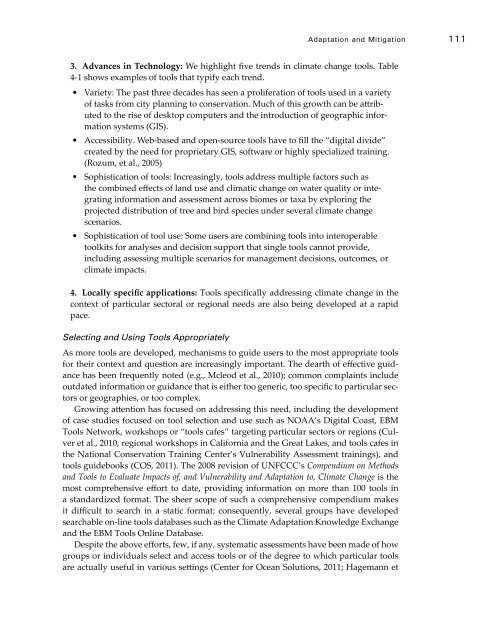Coastal Impacts, Adaptation, and Vulnerabilities - Climate ...
Coastal Impacts, Adaptation, and Vulnerabilities - Climate ...
Coastal Impacts, Adaptation, and Vulnerabilities - Climate ...
Create successful ePaper yourself
Turn your PDF publications into a flip-book with our unique Google optimized e-Paper software.
<strong>Adaptation</strong> <strong>and</strong> Mitigation 1113. Advances in Technology: We highlight five trends in climate change tools. Table4-1 shows examples of tools that typify each trend.• Variety: The past three decades has seen a proliferation of tools used in a varietyof tasks from city planning to conservation. Much of this growth can be attributedto the rise of desktop computers <strong>and</strong> the introduction of geographic informationsystems (GIS).• Accessibility. Web-based <strong>and</strong> open-source tools have to fill the “digital divide”created by the need for proprietary GIS, software or highly specialized training.(Rozum, et al., 2005)• Sophistication of tools: Increasingly, tools address multiple factors such asthe combined effects of l<strong>and</strong> use <strong>and</strong> climatic change on water quality or integratinginformation <strong>and</strong> assessment across biomes or taxa by exploring theprojected distribution of tree <strong>and</strong> bird species under several climate changescenarios.• Sophistication of tool use: Some users are combining tools into interoperabletoolkits for analyses <strong>and</strong> decision support that single tools cannot provide,including assessing multiple scenarios for management decisions, outcomes, orclimate impacts.4. Locally specific applications: Tools specifically addressing climate change in thecontext of particular sectoral or regional needs are also being developed at a rapidpace.Selecting <strong>and</strong> Using Tools AppropriatelyAs more tools are developed, mechanisms to guide users to the most appropriate toolsfor their context <strong>and</strong> question are increasingly important. The dearth of effective guidancehas been frequently noted (e.g., Mcleod et al., 2010); common complaints includeoutdated information or guidance that is either too generic, too specific to particular sectorsor geographies, or too complex.Growing attention has focused on addressing this need, including the developmentof case studies focused on tool selection <strong>and</strong> use such as NOAA’s Digital Coast, EBMTools Network, workshops or “tools cafes” targeting particular sectors or regions (Culveret al., 2010, regional workshops in California <strong>and</strong> the Great Lakes, <strong>and</strong> tools cafes inthe National Conservation Training Center’s Vulnerability Assessment trainings), <strong>and</strong>tools guidebooks (COS, 2011). The 2008 revision of UNFCCC’s Compendium on Methods<strong>and</strong> Tools to Evaluate <strong>Impacts</strong> of, <strong>and</strong> Vulnerability <strong>and</strong> <strong>Adaptation</strong> to, <strong>Climate</strong> Change is themost comprehensive effort to date, providing information on more than 100 tools ina st<strong>and</strong>ardized format. The sheer scope of such a comprehensive compendium makesit difficult to search in a static format; consequently, several groups have developedsearchable on-line tools databases such as the <strong>Climate</strong> <strong>Adaptation</strong> Knowledge Exchange<strong>and</strong> the EBM Tools Online Database.Despite the above efforts, few, if any, systematic assessments have been made of howgroups or individuals select <strong>and</strong> access tools or of the degree to which particular toolsare actually useful in various settings (Center for Ocean Solutions, 2011; Hagemann et
















